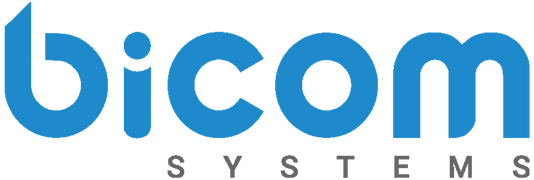In the modern era, the concept of call centers has somewhat diminished in value due to the rise of alternative, digital forms of communication.
However, most call centers have chosen to adapt to the times and evolve into contact centers, expanding their support coverage from just handling calls to also include emails, Live Chats, VoIP, chatbots, instant messaging and the like, wholly embracing the digital revolution.
It may feel like a mouthful, but all these new forms of digital communication are found under an umbrella term that is easier to relay, omnichannel support.
Much like their predecessors, the call centers, contact centers still focus on providing customer service, but the processes to support that have been modernized and automated to improve upon customer experience and employee workflow.
But how does this new brand benefit you? Why invest in it?
That is what we are here to find out today, so let us begin.
What Is A Contact Center?
Simply put, a contact center is a department where companies handle all forms of customer interaction across a large number of communication channels.
Depending on the type of company and its capabilities, their communication coverage can vary, but the goal of providing an elevated level of customer service while helping boost sales through lead generation and customer insights remains largely the same.
This goal is expanded upon even further the more forms of communication a contact center covers as it boosts the amount of customer input received, making room for adjustments that favor both the customer and the business.
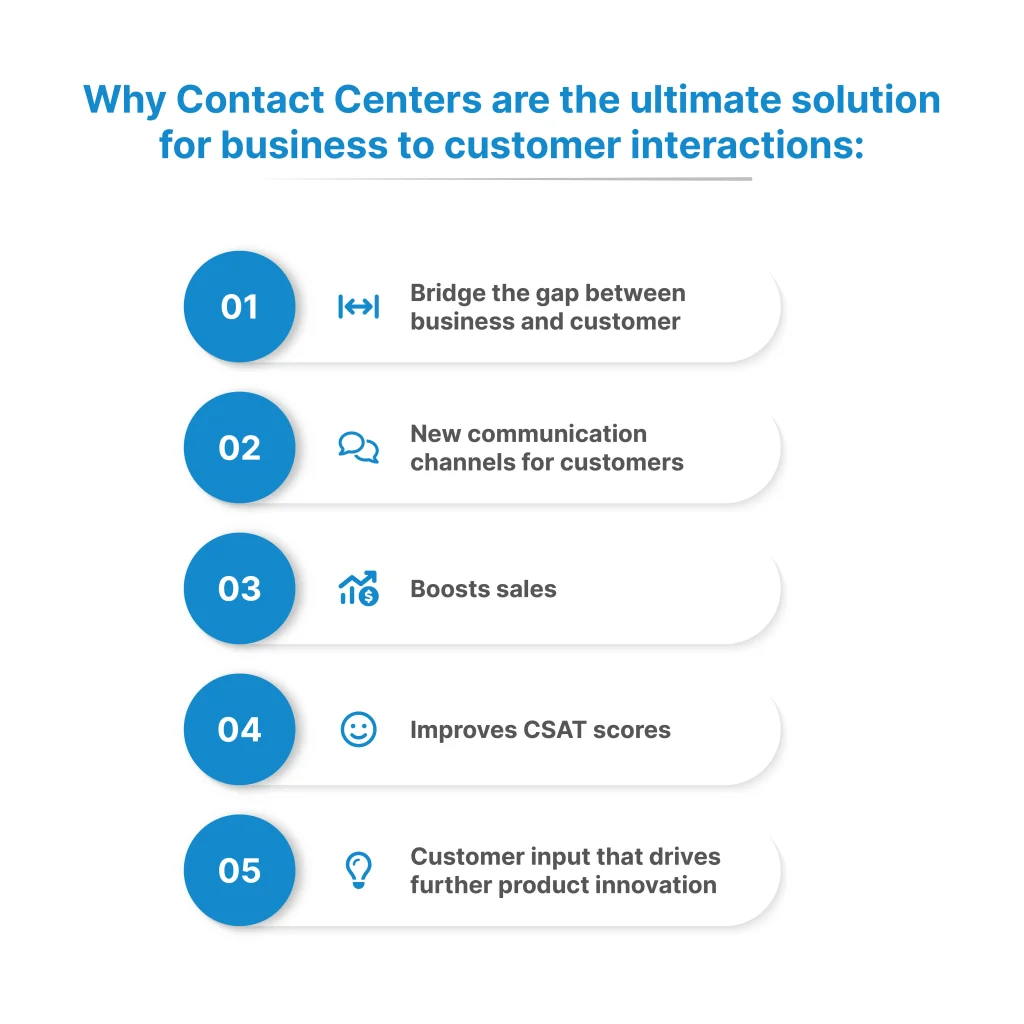
What Types Of Contact Centers Are There?
On top of learning about the many improvements contact centers incorporate over their call center predecessors, it is important for you to know the distinctions between the many forms that contact centers themselves can take.
They can vary wildly based on their intent, the amount of communication channels covered, and method of deployment.
Some of these are not mutually exclusive and contact center solutions can be formed from a mix of these different types.
Inbound, Outbound & Blended Contact Centers
The first three types are based around their intent which are usually designated by what type of service utilizes them, the inbound and outbound contact centers as well as their fusion, the blended contact center solution.
Inbound Contact Center
“...anything ranging from simple product inquiries over social media to tech support.”
The inbound contact center is based entirely around providing customer service and taking inbound calls.
This can be anything ranging from simple product inquiries over social media to tech support.
Before the appearance of the contact center, this all used to be handled over a multitude of phone calls which often lead to congested lines during times of heavy traffic and incredibly long wait times, gradually degrading the overall customer experience.
However, with modern technologies, these issues have been somewhat alleviated either due to automation or internet access.
Automation on its own was a great help, with inbound customer queries getting handled by interactive automated systems, be it IVR for voice calls or chatbots for live chat inquiries.
All of these were designed to deliver answers to some of the more commonly asked questions within the customer base and deliver news and updates on service outages, as well as helping categorize the type of inquiry.
This, in turn, helped remove a lot of unnecessary call retransfers by getting customers to an agent specialized to handle their query sooner and helping handle their issue much quicker.
A good number of these “calls” with simpler inquiries would also just get resolved on the automated system alone without needing to get an agent involved whatsoever.
All of this helped play a big role in drastically reducing agent workload, allowing contact centers to process a far greater number of queries in a day.
It also allowed them to redistribute their resources to handle different communication channels without increasing operating costs.
A good example of an inbound contact center would be any form of tech support, helpdesk or hotline.
Outbound Contact Center
“...agents in outbound CCs will utilize existing leads processed through a CRM system in order to find the most receptive customers…”
An outbound contact center is not as focused on customer service as it is on making sales, promoting products, and generating leads.
Its goals are not defined by the number of customers processed, but rather by the amount of sales made, increasing brand awareness, enabling business growth, increasing the customer base, or other metrics which help facilitate them.
In order to achieve this, agents in outbound contact centers will usually utilize existing leads processed through a CRM system in order to find the most receptive customers and the best communication channel to promote through.
Afterwards, agents will contact current and potential customers through different communication channels, be it cold-calls over the phone, newsletters via emails, promotional campaigns over messages or social media and the like.
Some good examples of outbound contact centers would be anything related to telemarketing or any business with an existing marketing team.
Blended Contact Center
“A good number of businesses utilize the blended approach in order to optimize their resources and free them up for other tasks.”
The third example here is that of a mix between an inbound and an outbound contact center, where agents perform both roles interchangeably.
While it is harder to achieve than the prior two examples given the level of knowledge required by agents, CRM systems and automation have made it more feasible.
A good number of businesses utilize the blended approach in order to optimize their resources and free them up for other potential tasks.
Multi & Omnichannel Contact Centers
“85% of businesses say “increasing the use of digital channels” will become more important as contact centers look to 2025.“
Source: CCW
The next two contact center types revolve around the number of channels that they manage.
Unlike with previous examples, there is not much of a distinction between the two, but some does exist.
Multichannel Contact Center
“...more common in SMBs that work with limited resources…”
As the very term implies, agents in a multichannel contact center cover a number of different communication channels depending on the scope and budget of the business that it is attached to.
This type of contact center is more common in smaller businesses that do not have the required infrastructure or workforce to manage every digital communication channel and instead offer what their capacity and capabilities allow for.
Omnichannel Contact Center
“Omnichannel CCs, while great, are not a requirement for every business.”
Omnichannel contact centers have agents that cover every digital communication channel available because they have the underlying infrastructure to do so.
They are capable of being more efficient when interacting with customers due to greater reach and a more seamless conversation experience allowing agents greater insight into customer inquiries, ensuring faster and smoother client handling overall.
While having an omnichannel contact center is better in a lot of aspects, not every business has the capacity to afford one, nor does it need one.
Businesses with an outbound or blended contact center solution should invest into one as it will greatly improve their customer interaction and workflow, but inbound contact centers can manage just fine with a multichannel structure.
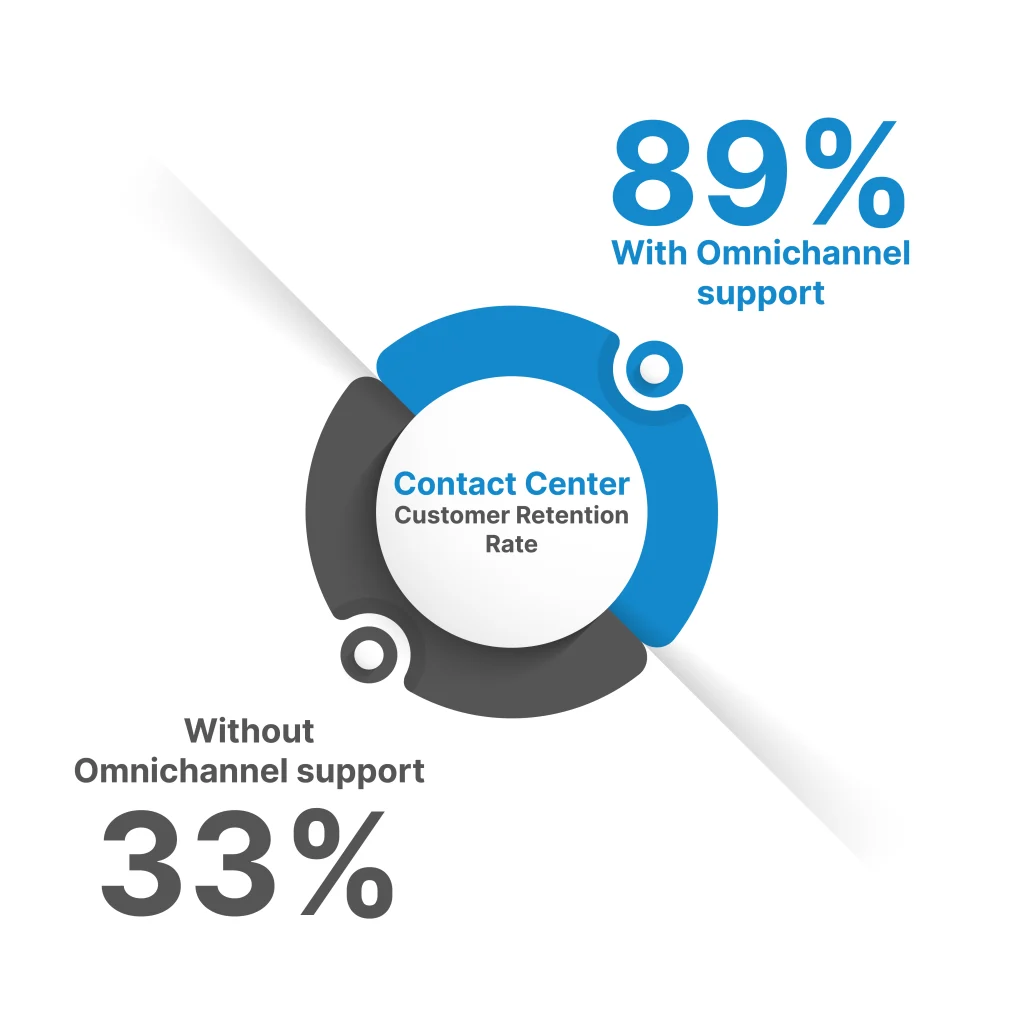
Cloud & On-premise Contact Centers
The final distinction revolves around the way that contact centers are deployed and can be either a cloud contact center, or an on-premise one, each with their own distinct benefits.
Cloud Contact Center
“Easier to set up with a wider agent talent pool.”
A cloud-based contact center is hosted on the cloud of a third party, usually marked as CCaaS.
It comes with its own defined advantages, the first one being lack of maintenance costs and its availability, allowing agents to work from anywhere in the world as long as they have a stable internet connection.
This allows for greater employee flexibility and offers a wider cadre of potential agents when hiring as there will not be a requirement to be in one specific location as opposed to an on-premise solution.
Minimal integration and setup time are another key benefit since cloud-hosted contact centers are usually an out-of-the-box solution that can be deployed quickly.
This allows businesses to start operating a lot sooner than an on-premise deployment would be able to.
Scalability becomes a non-issue as well since new lines can be deployed within a few mouse clicks, removing the need for any additional physical installation that would be required for the same undertaking in an on-premise contact center.
That said, while cloud-based contact centers are likely to be the future as they have already overtaken on-premise installations in a 54%>46% ratio in terms of investment according to the IDC, they are not without their own drawbacks.
While the upfront sum is nowhere near as high as an on-premise option, there are still annual, or even monthly, subscription fees that need to be paid which can end up being a hassle in the long run.
Also, not having all of their data on their own servers can make some businesses uncomfortable, especially if a lot of it is sensitive information.
That is why some businesses will gladly opt for an on-premise contact center solution to empower them to manage their data security in-house.
Finally, not all cloud contact center solutions are ideal for businesses. They may be too inflexible for their needs which would lead to them paying extra for features that they would never utilize.
Thus, businesses with very particular requirements are more likely to opt for an on-premise option.
On-premise Contact Center
“More infrastructure flexibility and better data security.”
On-premise contact center solutions are a more traditional form of setup, requiring an on-site location which takes a long time to deploy which is not ideal when a business wants to start interacting with its customers as soon as possible.
The initial price point is a lot higher than the alternative which will also include maintenance and upgrade costs down the line as well as the creation of a dedicated maintenance team to manage all of it.
However, businesses that can front these costs and have the resources to facilitate these requirements enjoy greater data security and overall call quality.
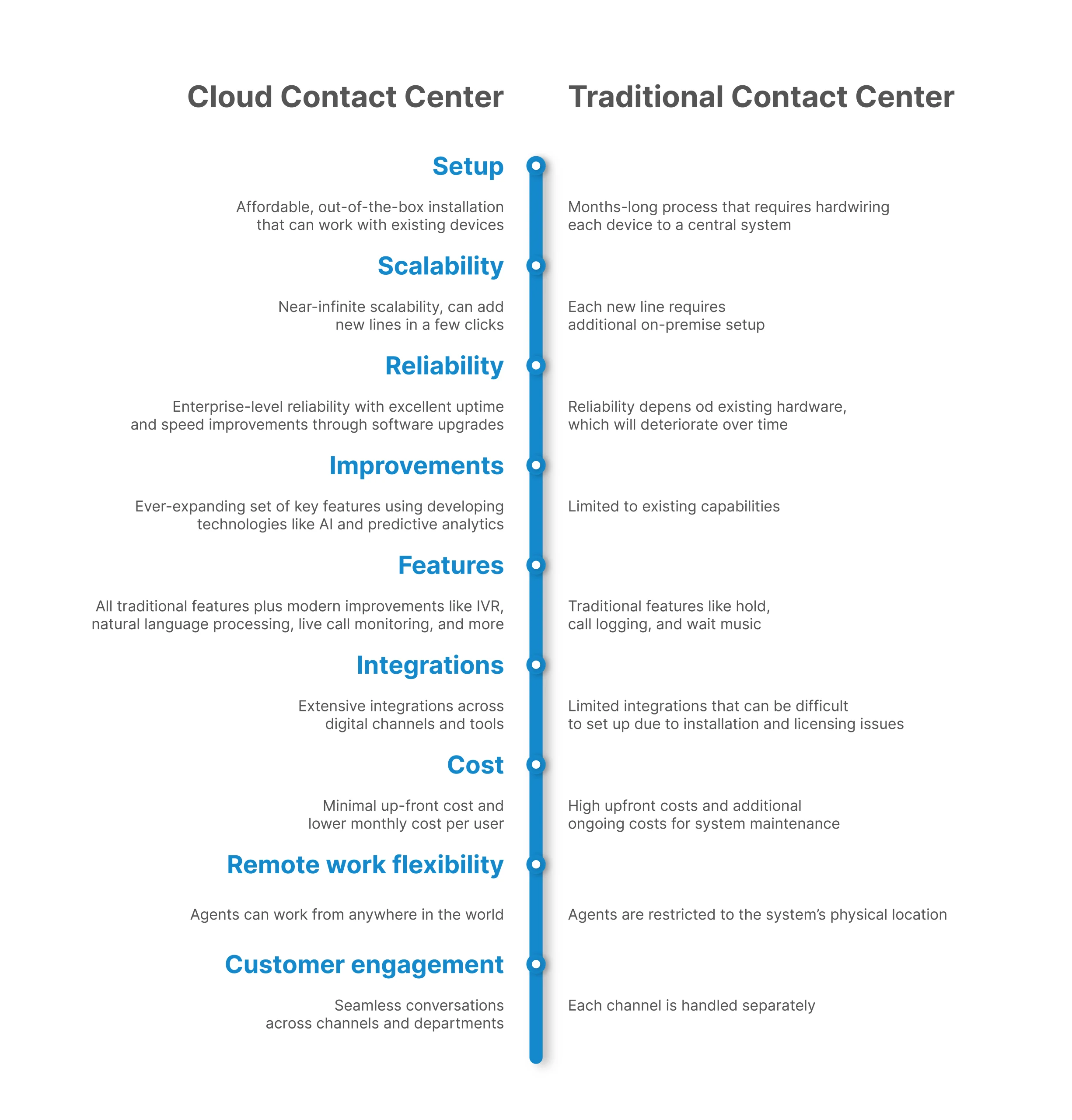
Find out more about Cloud vs. Hosted Contact Center Solutions.
The Key Benefits Of A Contact Center Solution
A contact center is a must have in most modern businesses, but not everyone is aware of the abundance of boons that come with them.
Here are a few important benefits to highlight when presenting a contact center as a solution to potential buyers:
Adding New Communication Channels For Customers
Opening up more avenues of communication for customers than just phone calls allows businesses to get input from a more diverse customer base and through a channel that may be easier for them to communicate through, enhancing their overall customer experience.
Improving Customer Experience
With limited resources, dealing with a large number of calls can be challenging and detrimental to the customer’s overall experience.
When implementing a contact center into a business, this problem gets resolved through automation, be it through IVR, ACD or online chatbots, redirecting call traffic down the proper lanes to get queries answered quicker.
Personalizing Customer Interaction
“40% of customer service decision-makers consider CSAT scores as their most commonly used customer service metric with a further 23% considering it their beacon metric of CX measurement. “
Source: Forrester
Integrated CRMs can further improve CX by empowering agents to form a closer connection to the customer and their needs.
The customer data provided to the agent facilitates this by giving them insights to prior conversations with the customer, personalizing their experience and improving it overall.
Flexible Resource Management
Agents are a finite resource and one can only take so much work at any given time.
Thanks to the automation options that contact centers are equipped with, said resources are freed up to go through more customers by reducing customer handling time or reallocating agents to a different position to grow and improve the business.
On top of that, businesses opting for a cloud-based contact center solution gain further benefits through a larger cadre of employment, allowing them to get higher quality agents since they are not limited to a physical location.
These improvements will ultimately stretch to the customers as well by providing them with a higher quality of service and better customer experience.
Round The Clock Customer Support
Normally, agents working reasonable hours would not be able to cover customer inquiries all day, but with automated processes like IVR and chatbots, it has now become feasible, albeit in a limited capacity.
They cannot help out with super specific inquiries, but they can help identify some of the more common issues and, hopefully, resolve them.
If, however, a business is running a virtual call center and has agents in several locations across the globe, live, round the clock customer support is possible and preferred if the business can manage it.
Expanded Customer Service Team Management
Integrating a contact center into a business provides managers with the tools to easily manage agents and their workload as well as gain insights into their performance.
They can gain access to blended reports and analytics showcasing agent performance across all communication channels.
Managers can also gain the ability to monitor calls in order to better note the pain points in a particular agent and suggest improvements, or to assist with the onboarding process of a new agent.
Determining Which Contact Center Best Fits Which Business
Recognize what each business needs and provide a solution that best fits within that framework.
Finding the best fit for an individual business is done on a case-by-case basis as all of them have different requirements. The important thing is to recognize what they are and find the most ideal solution with as few unnecessary features as possible.
This can be easy at times, but, for others, it can be a chore when no product fulfills a specific business’s needs.
Find out more about Contact Center technologies.
There are a few key things to be on the lookout for when presenting a contact center solution to a business to make sure it is a quality product:
1. Proper Call Routing
The baseline of a good contact center product is having fast and structured query routing.
The faster and more efficiently a customer’s query is resolved, the higher the call volume that agents can manage and, subsequently, the better the customer experience.
All of this is managed through automation technologies that every modern center should have, IVR and ICR.
IVR plays the role of the traffic control officer, directing customers to the right agents, or “lanes” based on the data gathered from a few given prompts, after which the ICR further redistributes the traffic based on customer priority and agent availability.
While the two work relatively similar roles, the two functioning in tandem greatly enhance CX within the contact center by improving handling speed, query volume, and customer interaction.
2. Further Automation Options
Aside from IVR and ICR, there are other automation features that are mutually beneficial for customers and businesses like chatbots and automated ticket creation.
Chatbots
Chatbots used to be limited to specific communication channels before, namely phones, messaging or social media, but have since evolved to utilize an omnichannel approach.
Thanks to the growing accessibility of AI and the many advances in the field, chatbots keep expanding their functionalities by the day, though still have a few kinks to work out that may prove detrimental to overall CX.
Older variants of chatbots that navigate down decision trees are a solid alternative and still see common use, but the few kinks that an AI chatbot might have are far outweighed by its many advantages.
Automated Ticket Creation
An automation feature that helps beat out the busywork of manual ticket creation by inputting relevant call data directly on the ticket with a lot less input on the agent’s side, streamlining the customer handling process and allowing the agent to get to the next query faster.
Automated Emails
Automated emails serve a crucial purpose in improving the business’s brand with its customer base.
As the name implies, they are an email message sent out to users who have hit a specific trigger to receive them, be it a welcome message email for registration or a confirmation email for newly registered users.
Many other forms of them exist, but they all serve the same purpose as customers are more likely to engage with automated emails from businesses rather than marketing related ones.
3. Call Scripts
Call scripts are an old method that enable agents to create closer connections with their customers by acting as a knowledge base of information.
It allows for smoother conversations while eliminating pauses during the interaction, keeping the flow going and making the customer feel more at ease that their query is being handled professionally.
A well categorized call script will not only benefit agents, but automated chatbots too as it can serve as an efficient learning tool for their integration.
4. Easy Access To Customer Data
All high quality contact center solutions will gather customer data with the sole purpose of improving future interactions. However, making that data comprehensive and easy to access in a unified workspace for agents during calls is crucial in delivering the optimal customer experience.
The quicker an agent can access customer data, the more efficient they will be at handling their query, improving customer loyalty and employee satisfaction due to the existence of this consolidated workspace.
5. Comprehensive Contact Center Data Analytics
While the success of a contact center relies greatly on customer satisfaction, another key metric is agent performance and employee satisfaction, something which can be hard to gauge in a large enterprise.
That is why a key feature of every contact center is having access to analytics that report on a number of different, important metrics on an overall and per agent basis, helping showcase any potential pain points that may need to be looked at and evaluated.
Having a contact center solution with an intuitive dashboard is important too, often coming pre-built with the most relevant metrics on display.
Omnichannel contact centers can even have the option of blended reports and dashboards, showing the metrics of every communication channel together in one place.
6. Multiple Communication Channels
While not expressly required, utilizing the main selling point of a contact center solution goes without saying.
The more communication channels it can support, the more approachable the business will appear to its customers.
Frequently Asked Questions
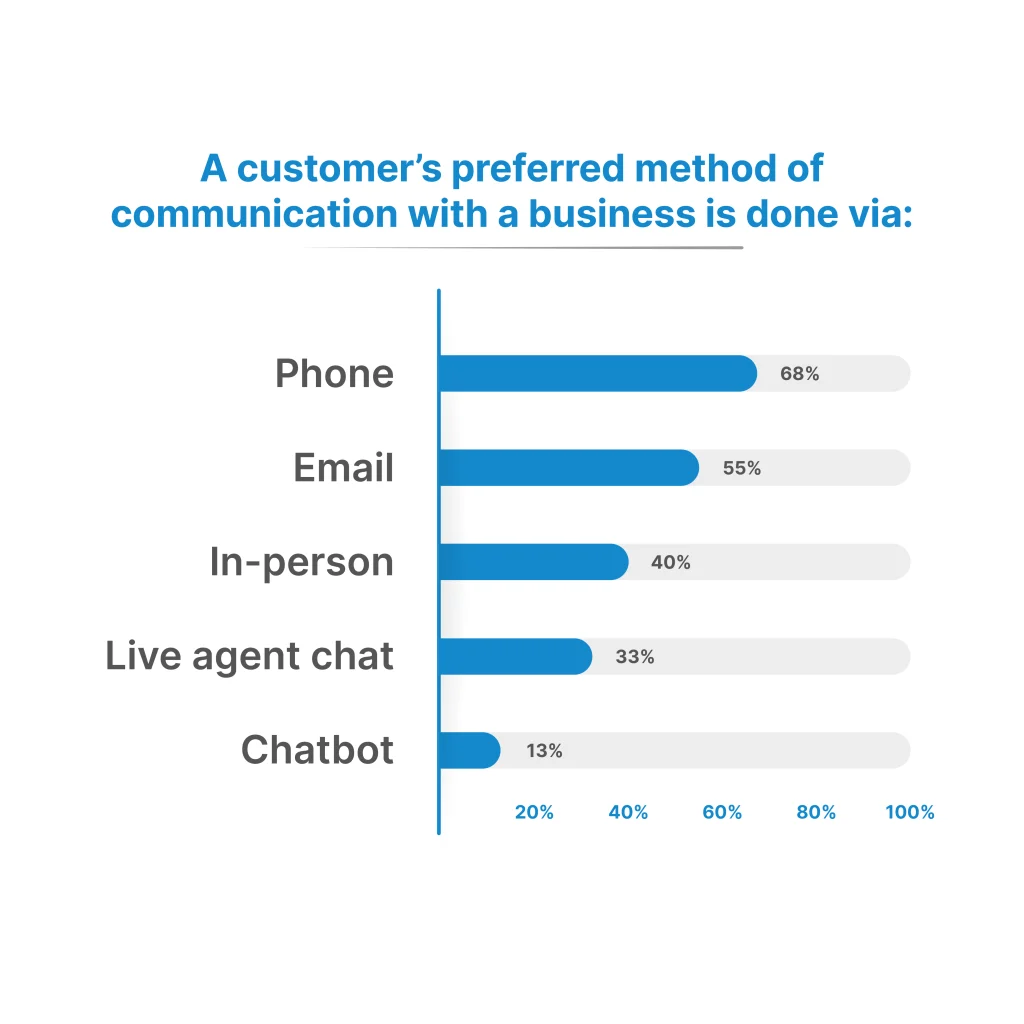
Here are several questions that businesses will often ask when a contact center solution is offered to them:
Are Contact Centers Necessary For A Business To Operate?
While not mandatory for some businesses, they are a pivotal asset for businesses as they aid in brand recognition and customer satisfaction.
They also provide a good source of customer insights and data to help businesses continue to grow and be successful by adapting to the needs of their customer base.
What Is The Best Contact Center Solution?
There is no single best option that works for every business. They all have their niche and it is important to recognize the strengths of each contact center type and leverage it against the specific needs of the business in order to create the most suitable offer.
Ideally, the business would want a contact center that can integrate itself well into its existing infrastructure without having to uproot it and would have to support existing communication channels while adding new ones.
For growing businesses, it is important that their chosen solution can scale together with the business and keep up with the demand.
Other than that, other features are optional but ones like automation will be a great help on top of any specific ones that a business may require to support their operations.
How Does A Contact Center Solution Benefit Customers?
“66% of consumers said a bad interaction with a business can ruin their day.”
Source: Zendesk’s CX Trends Report
It gives them a way to interact with the business on a deeper level, helping out with their inquiries and offering a personalized experience throughout the process, improving their overall satisfaction which leads to an improved brand image for the business.
How Does A Contact Center Solution Benefit Agents?
It enables them to interact with the customer in a natural and fluid manner by providing them with the relevant customer data beforehand as well as the tools necessary to quickly resolve a customer’s inquiry.
Various automation functionalities also help streamline the agent’s overall workflow by only leaving them to deal with more pressing, nonstandard issues while the more common ones are relegated to FAQs and chatbots.
And, ultimately, with better tools that improve agent quality of life comes better employee satisfaction which, in turn, translates to a better customer experience.
Do Agents Need Extra Training To Work In A Contact Center Environment?
If they are familiar with call centers, it will not take much, but extra training can help with faster acclimation. Some contact center solutions even have built-in tools to facilitate easier onboarding processes.
They should at least be familiarized with all of the tools at their disposal before starting work within a contact center. The manager can help monitor them afterwards as well as assist or coach them over time if they see the need for it.
Are Contact Centers Expensive To Deploy And Maintain?
That depends on the type of deployment and the provider.
On-premise deployments will have a larger up-front cost with added maintenance costs and extra manpower requirements, but offer benefits like greater data security and flexible customization.
Cloud-based deployments have much smaller costs that include equipment costs for agents and can include either a monthly or annual subscription fee to the service provider.
Some providers offer flexible payment plans based on the number of agents which can scale with the inquiring business, but it varies from one provider to the next.
Find out more about Contact Center providers.
An Unmatched CX Solution

Contact centers as a solution for business-to-customer interaction are here to stay. They are a mutually beneficial tool that provides businesses with customer insight empowering them to continue growing while giving them the tools to satisfy the needs of their customer base.
Bicom Systems has its own (Omnichannel) contact center solution too. Be sure to give it a look or contact us for more information.
